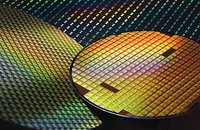Tuesday, February 12th 2019

TSMC 7nm EUV Process to Enter Mass-Production in March 2019
TSMC is giving final touches to set its flagship 7 nanometer EUV (extreme ultraviolet lithography) silicon fabrication node at its highest state of readiness for business, called mass-production. At this state, the node can mass-produce products for TSMC's customers. TSMC had taped out its first 7 nm EUV chips in October 2018. The company will also begin risk-production of the more advanced 5 nm node in April, staying on schedule. Mass production of 5 nm chips could commence in the first half of 2020.
The 7 nm EUV node augments TSMC's 7 nm DUV (deep ultraviolet lithography) node that's been already active since April 2018, and producing chips for AMD, Apple, HiSilicon, and Xilinx. At the turn of the year, 7 nm DUV made up 9 percent of TSMC's shipments. With the new node going online, 7 nm (DUV + EUV) could make up 25 percent of TSMC's output by the end of 2019.
Source:
DigiTimes
The 7 nm EUV node augments TSMC's 7 nm DUV (deep ultraviolet lithography) node that's been already active since April 2018, and producing chips for AMD, Apple, HiSilicon, and Xilinx. At the turn of the year, 7 nm DUV made up 9 percent of TSMC's shipments. With the new node going online, 7 nm (DUV + EUV) could make up 25 percent of TSMC's output by the end of 2019.

18 Comments on TSMC 7nm EUV Process to Enter Mass-Production in March 2019
EUV exposure is done by a small "blast" (complicated plasma stuff) that creates a burst of rays and guides the rays through complicated means (not lens) to in the right shape for exposure.
DUV still works with lens made from exotic materials (but traditional patterning)
Totally not compatible, but since these have been in the works for many years already, no surprise that it's now finally read for mass production.
Also, did you read the "Mass production of 5 nm chips could commence in the first half of 2020" part?
You take some matter, you heat it up and it starts to emit energy in different forms. Tin used in this process emits EUV.Again: not that hard to understand. I assume most of us have seen a concave mirror and know from experience that it can be used to focus light. :-)
Problem with Extreme UV (few times shorter wavelength compared to UV in "DUV") is that it's easily absorbed by matter. The whole EUV process takes place in very high vacuum and it would be hard to make a lens that works in this setup - even a gas one (it would absorb too much).
But it is possible to replace a lens with a set of curved mirrors.
Sadly, no magic. :-)
And beside AMD (and those monbile phone makers) who is using TSMC's 7nm?? Nvidia??
Also do consider that Apple is rumored to be working on in-house CPU and GPU. They have 10-15% market share in personal computers. Basically, if they really wanted, they could use all TSMC 7nm potential for the next few years. :-)
"Mid-tier" is what actually matters. A good 7nm process will improve power efficiency and reduce size. That's what AMD needs to make Navi successful.
At first 7nm supply will be very limited, so AMD will use it for the mainstream products. The less important high-end parts will have to wait (or AMD may not make them at all).
Console makers' patience is limited, but they are staying with AMD for next gen.
AMD must have promised them them a huge improvement in efficiency...
7nm EUV should provide ~~ density of 100 or 4x that of 14nm.
That doesn't make sense even without me pointing out that Vega 20 is a 7nm part while mainstream parts are not.
And what doesn't make sense? AMD makes GPUs that aren't even close to what next gen consoles are supposed to be. That's the demand they have to protect.
The battle in high-end PC gaming is lost at this point. They may try again (and they should), but only after they secure some sensible cashflow. You know... in case Nvidia makes a better GPU anyway and AMD has to file for bankruptcy. Makes sense now?